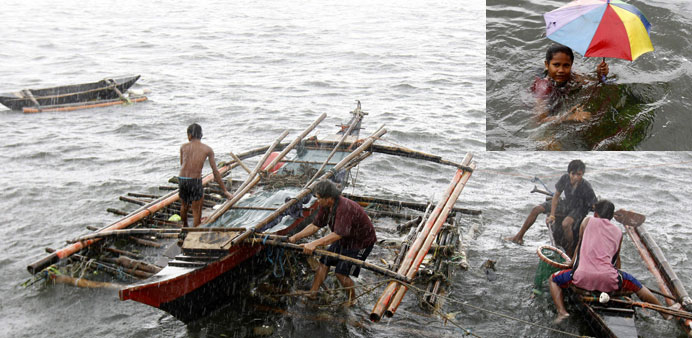A Filipino fisherman braves strong waves at a coastal village in Manila. Inset: A Filipino teen holding an umbrella frolics in the Bay of Manila yesterday.
The strongest typhoon to hit the Philippines this year flattened houses, caused flash floods and triggered landslides in remote towns yesterday, killing at least one person.
With gusts of 200kph, authorities said they feared many more people may have died as Typhoon Utor swept across coastal and mountainous regions of the northern Philippines.
“It looks like the death and damage toll is going to go up... with wind like this, you can expect a lot of damage,” Francis Rodriguez, a senior officer with the National Disaster Risk Reduction and Management Council, said.
Rodriguez said authorities would only receive reports from isolated villages that were in Utor’s direct path today.
Hundreds of people die each year in the Philippines from the roughly 20 typhoons that strike the country.
The wind from Utor, which made landfall before dawn yesterday, was the strongest recorded in the Philippines this year, while the typhoon also brought intense rain.
Rodriguez said the first confirmed fatality was a man crushed by a landslide while trying to clear a mountain road in the northern Benguet province. A local television cameraman in another northern province also filmed the horrifying ordeal of a woman who was swept down a swollen river on the thatched roof of her house.
The woman stood on the roof as if it was a surfboard, as people screamed out in alarm from high ground.
She quickly disappeared amid the crashing of the fast-moving water, and it was unclear if she survived.
Rodriquez said 13 fishermen were also still missing after they went out to sea as the storm approached.
Authorities said large areas of the coastal province of Aurora, where the storm made landfall, suffered heavy damage.
“Infrastructure, farms, homes were destroyed. Trees were knocked down,” Elson Egargue, Aurora’s disaster management officer, said.
He said the coastal town of Casiguran, home to about 20,000 people, was believed to have been hit particularly hard, although officials had yet to make contact with residents or authorities there.
“The roads in these areas are blocked because of landslides and overflowing creeks,” he said, adding mobile phone networks were also down.
He said there was also extensive damage to two other nearby towns, home to about 25,000 people.
In Manila, the nation’s capital, roughly 200km to the south of the storm’s path, there was heavy rain overnight and throughout yesterday but no major flooding.
Schools across the capital were closed yesterday in an automatic response to a government storm alert.
Such precautionary measures have become standard after the death tolls of storms in recent years have been exacerbated by poor preparations.
Over a thousand people were killed when Typhoon Bopha hit the Philippines in December, the deadliest storm in the world in 2012.
In 2009, more than 460 people were killed when tropical storm Ketsana led to flooding across 80% of Manila.
The weather bureau said the eye of Utor had travelled west out of the Philippine and into the South China Sea yesterday afternoon, going towards southern China.
But it said Utor was expected to continue bringing heavy rains to Luzon last night and today.
Authorities in Hong Kong said they were preparing for Utor to potentially dump heavy rains there this week. The Hong Kong Observatory raised a stage one typhoon alert. Stage 10 is its highest-level alert.
Other reports said the coastal town of Casiguran in Aurora province, 343 km northeast of the capital Manila, suffered the worst damage, after the typhoon set off landslides that blocked its only access road.
“About 90% of our agriculture was destroyed or damaged, particularly rice and corn crops and coconut plantations,” Aurora governor Gerardo Noveras told ANC television, adding that the full extent of damage was still unknown.
“We have restored power and communications in some towns, and we’re ready to deliver relief goods to affected families.”
But Casiguran and another coastal town were still isolated, he said.
Television showed images of devastation ranging from uprooted trees and fallen lamp-posts to tangled power lines and flattened houses. Most mountain roads were blocked by boulders and loosened soil.
The national disaster agency said a man clearing a clogged drain was killed when a landslide buried him in mountainous Benguet province, while 13 fishermen in the coastal provinces of Pangasinan and Camarines Sur were reported missing.
Police are also checking reports of three missing fishing boats, with 25 men aboard. But 9 fishermen earlier reported missing on the central island of Catanduanes have all been accounted for, disaster officials said.
Schools in the capital and most parts of Luzon were closed while two local carriers suspended 18 domestic flights. Sea travel halted and commuter buses were stalled.
About 20 typhoons hit the Philippines every year, often bringing death and destruction. A state of national calamity was declared last December after typhoon Bopha killed more than 700 people in the resource-rich south, but most storms make landfall further north.



